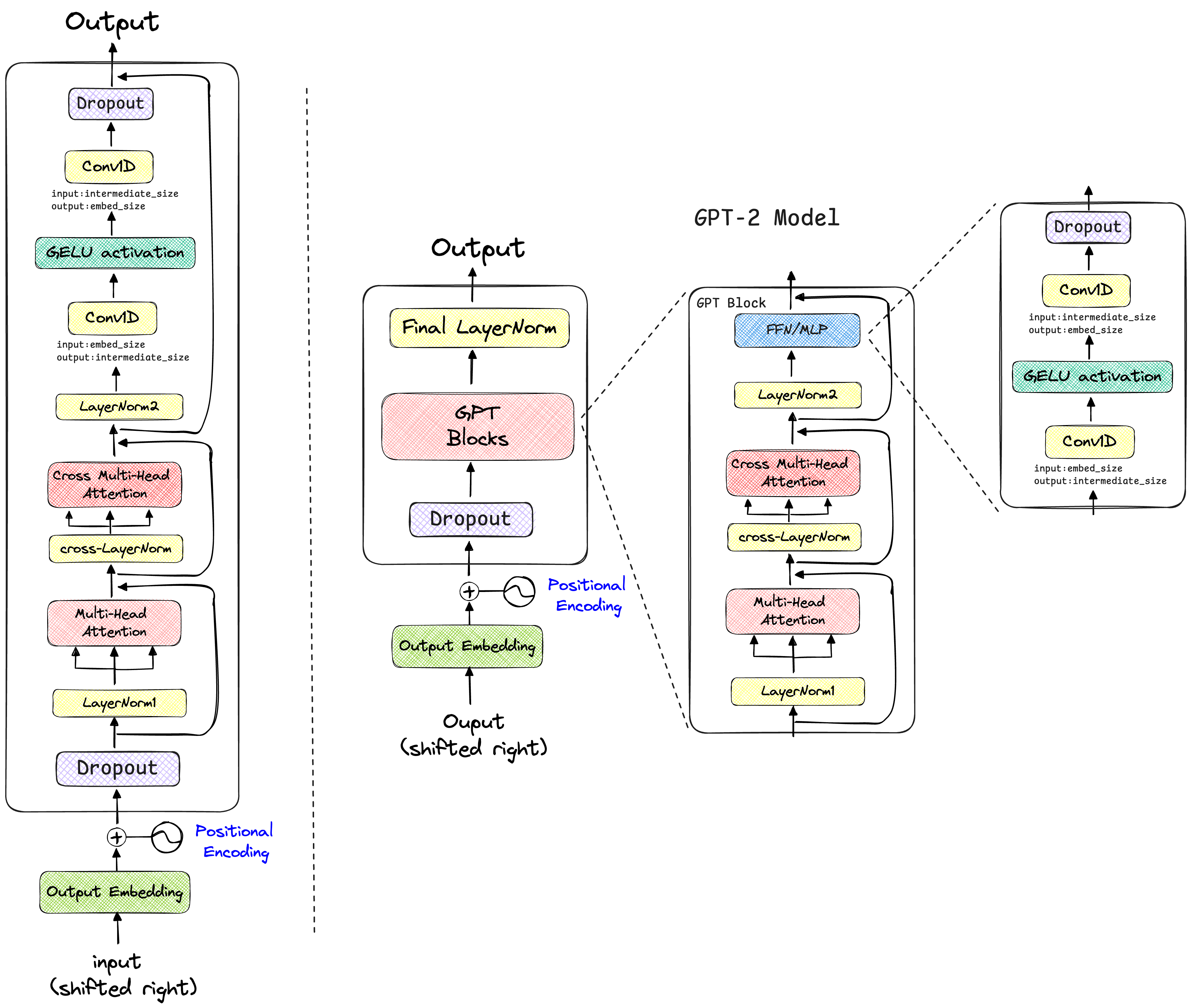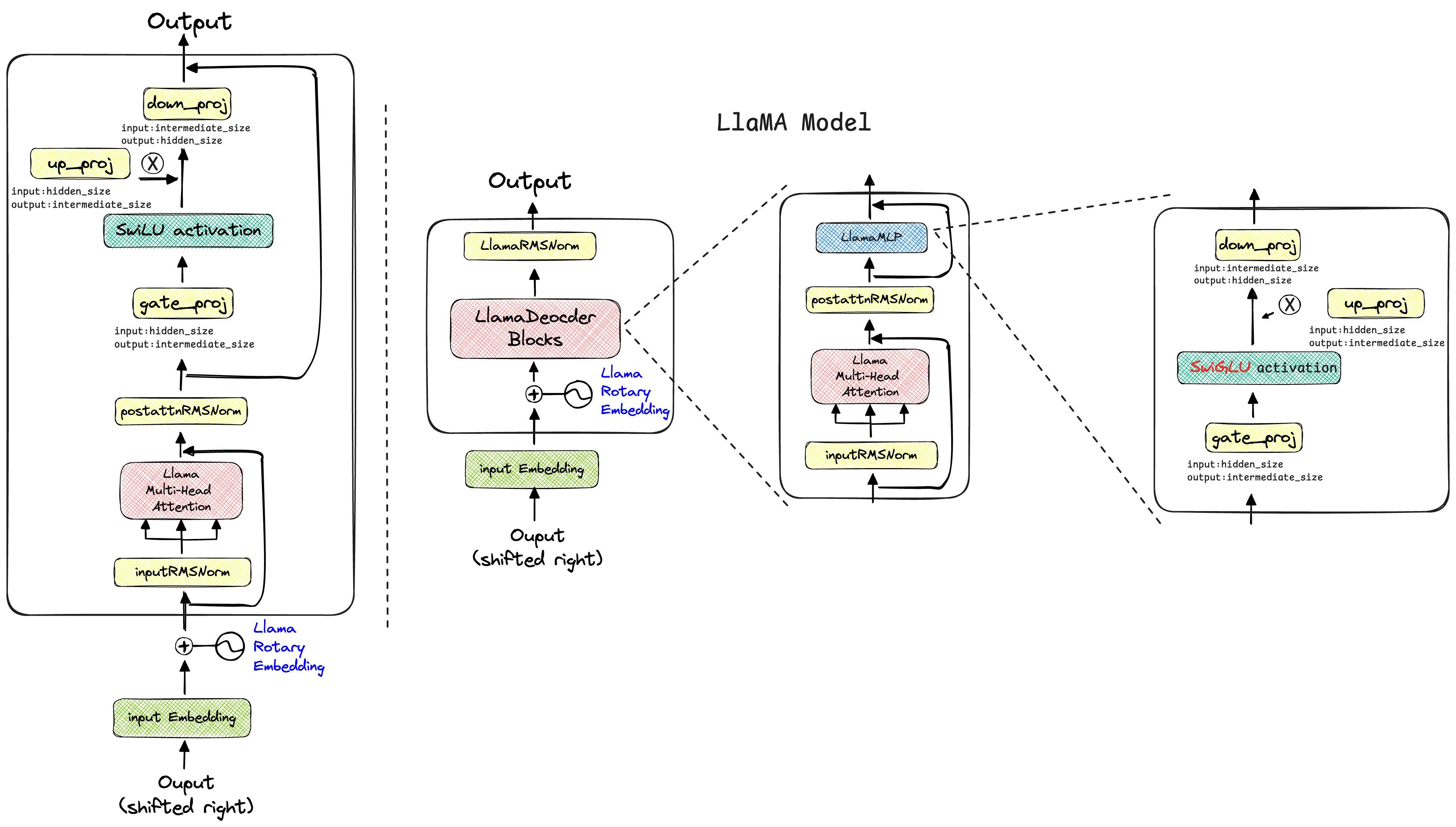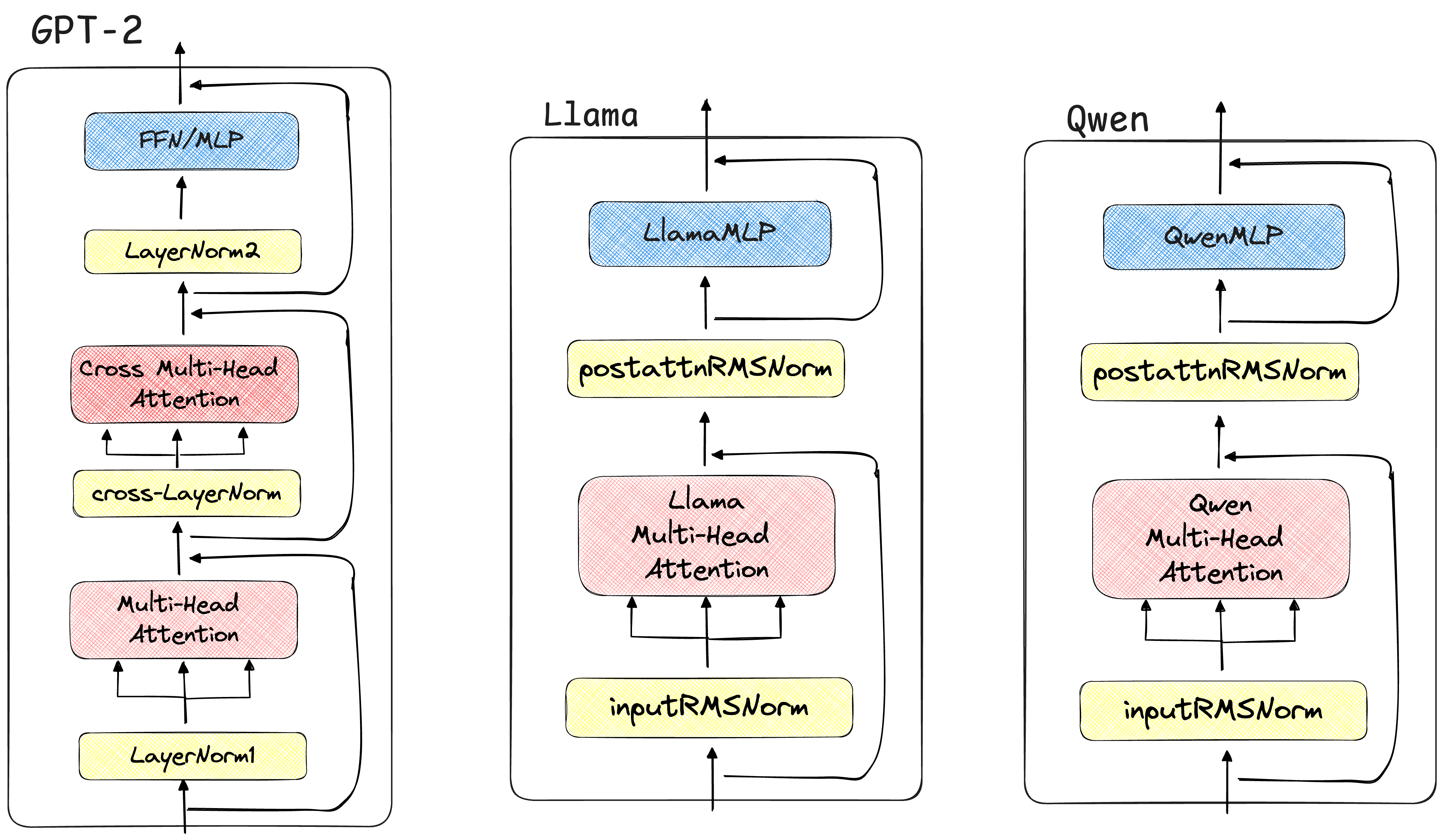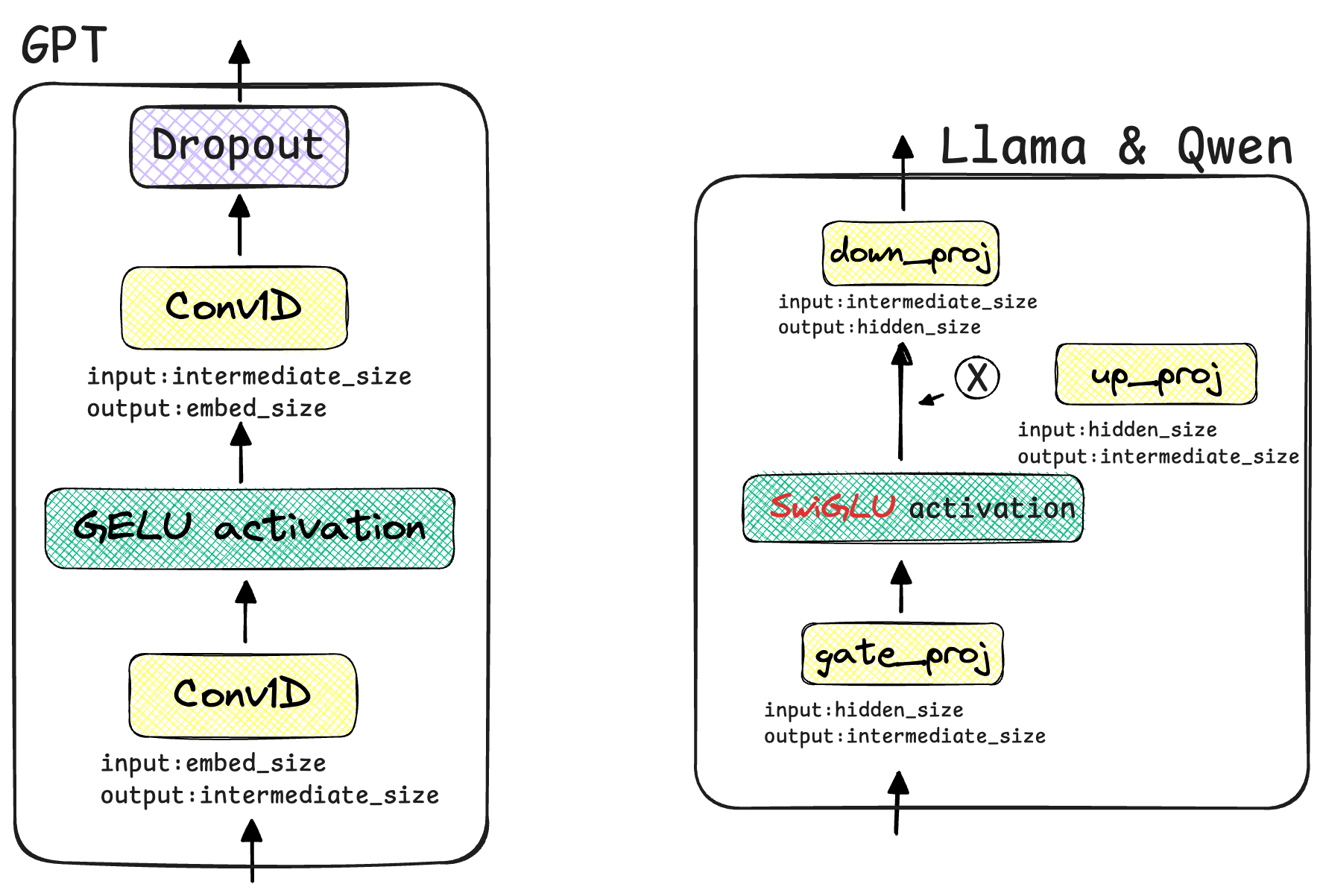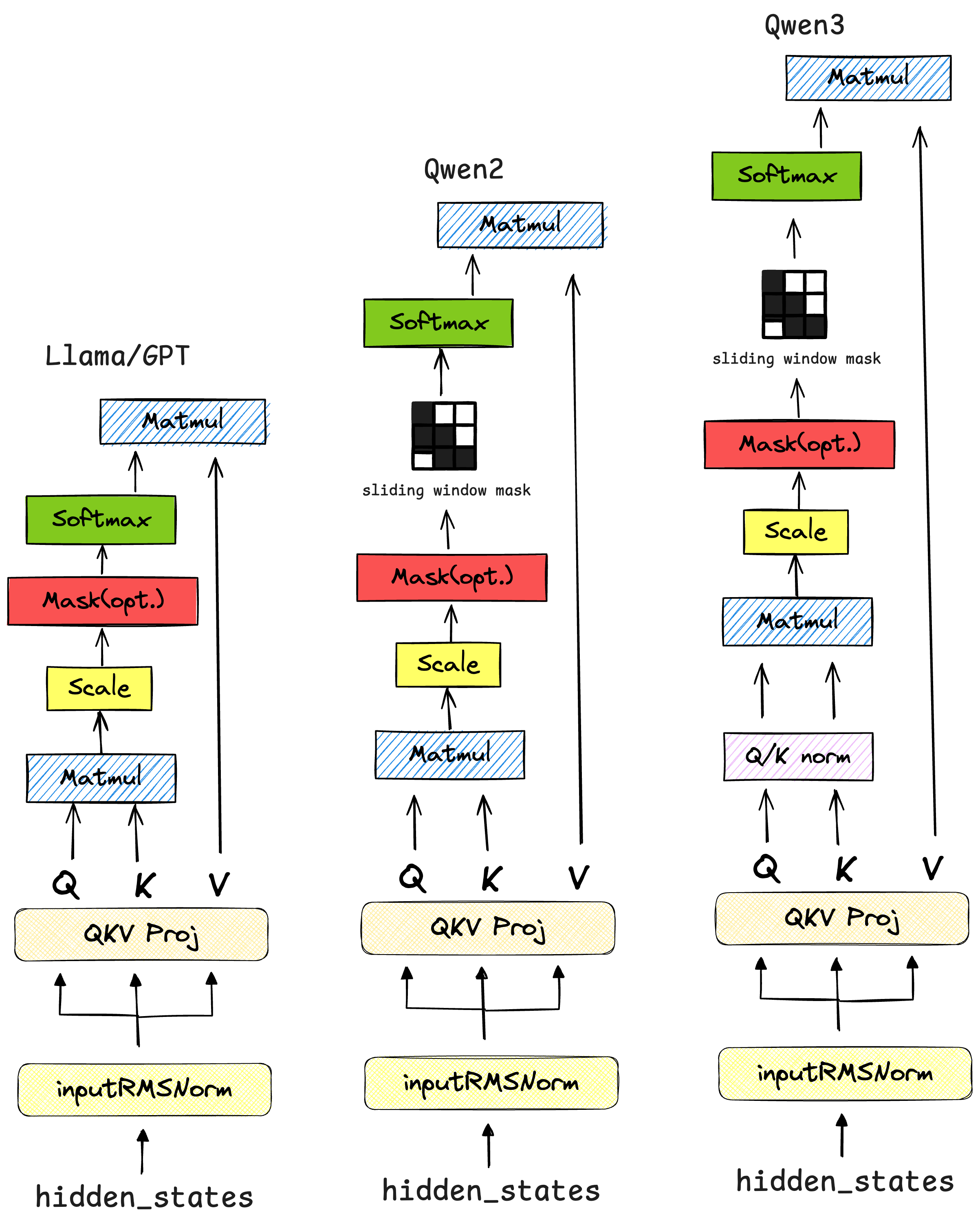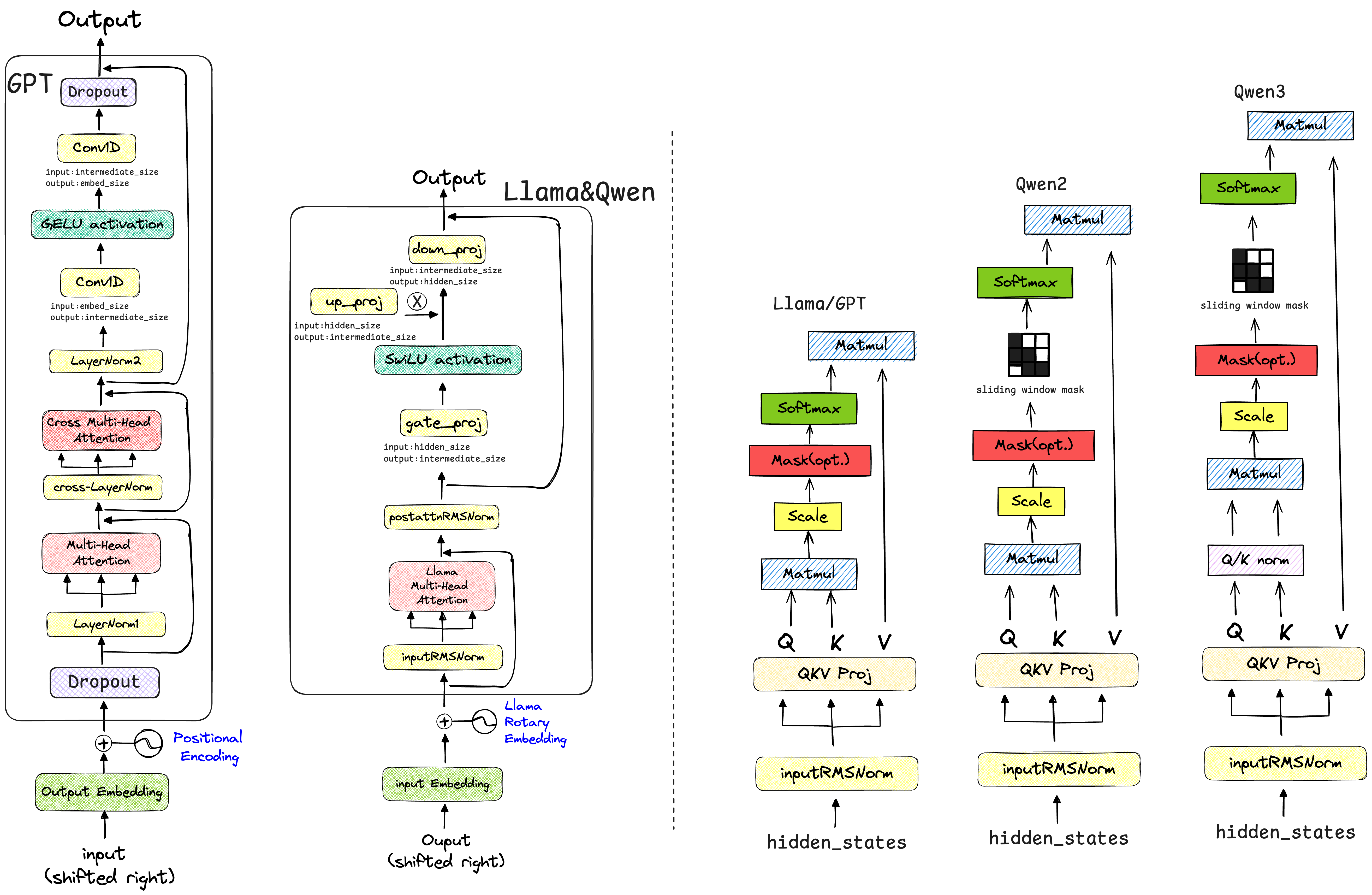九月份投递完第一篇论文初稿以后,认真把三个经典大模型架构的源代码阅读、复现了一遍。动机出于以下因素:首先,暑假期间读完了Sebastian Raschka 大佬写的Build a Large Language Model (From Scratch)这本书,把GPT-2的完整架构熟悉了一遍,但是一些具体的细节设计和GPT源代码还是有些区别。其次,考虑到后续论文复现的工作大多是建立在transformers库中的源代码基础之上,索性多花费了一些时间把“LLM三驾马车”的架构设计对比学习一下,知道后续在此基础之上如何去修改、动哪里。
全文是我在认真阅读并复现了GPT-2、LlaMA-2与Qwen3的transformers源代码后撰写的架构设计对比分析,如有失偏颇,烦请给位读者大佬们批评指正!
Top-Down 开篇先宏观理一下我对三个架构设计的对比分析:
整体架构设计上LLaMA的架构设计要比GPT架构更简洁 ,LLaMA舍弃了GPT架构中首位的Dropout层。
相比于GPT-2的绝对位置编码,Llama使用ROPE旋转位置编码。
相比于GPT-2中的LayerNorm层归一化,Llama使用的是RMSNorm层归一化,并且RMSNorm层主要用在LlamaDecoder后 、LlamaAttention块前后 、以及最后经过MLP输出后 。
在MLP层的设计上,LLaMA使用的SwiGELU激活+门控制方法,GPT使用GELU激活+Conv1D线性变换的方式。
Qwen2的源代码基本上和LLaMA源代码保持一致,相比于GPT-2和Llama架构增加了self.sliding_window滑动窗口注意力 部分。
Qwen3的源代码基本上和Qwen2源代码保持一致,只是相比于Llama和Qwen2,在计算注意力的时候增加了self.q_norm和self.k_norm的RMSNorm归一化层,提升训练的稳定性。
具体展开 LlaMA的简洁如何体现? 在GPT-2中,输入的词嵌入(Token Embeddings)和位置嵌入(Position Embeddings)相加后,会立刻经过一个nn.Dropout层,然后再进入Transformer的Decoder层堆栈。Llama直接将词嵌入送入Decoder层,省去了这个初始的Dropout。
通过阅读transformers库中的源代码,我绘制了GPT-2与LLaMA的模型架构对比图,如下所示:
观察上述架构设计图可知,实际上GPT-2和LlaMA的架构设计细节与《Attention is All You Need》、《Improving Language Understanding by Generative Pre-Training》论文里面绘制的模型架构图是有所区别的。
实际的数据转换过程应该是,经过位置编码后,进入模型的主体部分,GPT-2的数据流动过程为DropOut层 -> GPT Blocks -> Final LayerNorm,而LlaMA简洁就体现在去掉了GPT-2经过绝对位置编码后的Dropout层,使得输入数据经过旋转位置编码后,直接进入LlaMADecoderBlocks层,所以Llama模型的数据流动过程只有LlaMADecoderBlocks -> LlamaRMSNorm。
DecoderBlock 在DecoderBlocks里面,GPT-2主要先经过了多头注意力层,之后再经过多头掩码注意力块,之后输入到FFN网络中;而Llama的DecoderBlocks层中,只有一个多头注意力层计算块,之后便输入到LlamaRMSNorm层中;Qwen的DecoderBlocks基本上就是“继承”了Llama的源代码,只是注意力块与Llama模型有所不同。
通过阅读源代码,描绘了三个模型的DecoderBlock架构设计对比图如下所示:
GPT-2使用标准的LayerNorm ,而Llama的RMSNorm省去了LayerNorm中的“减去均值”这一步,只保留了“除以方差”的缩放,计算量更小,实验证明在性能上几乎没有损失。
三个模型的DecoderBlock层源代码如下:
1 2 3 4 5 6 7 8 9 10 11 12 13 14 15 16 17 18 19 20 21 22 23 24 25 26 27 28 29 30 31 32 33 34 35 36 37 38 39 40 41 42 43 44 45 46 47 48 49 50 51 52 53 54 55 56 57 58 59 60 61 62 63 64 65 66 67 68 69 70 71 72 73 74 75 76 77 78 79 80 81 82 83 84 85 86 87 88 89 90 91 92 93 94 95 96 97 98 99 100 101 102 103 104 105 106 107 108 109 110 111 112 113 114 115 116 117 118 119 120 121 122 123 124 125 126 class GPT2Block ():def __init__ (self, config, layer_idx=None ):super ().__init__()if config.n_inner is not None else 4 * hidden_sizeself .ln_1 = nn.LayerNorm(hidden_size, eps=config.layer_norm_epsilon)self .attn = GPT2Attention(config=config, layer_idx=layer_idx)self .ln_2 = nn.LayerNorm(hidden_size, eps=config.layer_norm_epsilon)if config.add_cross_attention:self .crossattention = GPT2Attention(config=config, is_cross_attention=True , layer_idx=layer_idx)self .ln_cross_attn = nn.LayerNorm(hidden_size, eps=config.layer_norm_epsilon)self .mlp = GPT2MLP(inner_dim, config)def forward ( ... ) -> Union [tuple [torch.Tensor], Optional [tuple [torch.Tensor, tuple [torch.FloatTensor, ...]]]]:self .ln_1(hidden_states)self .attn(if encoder_hidden_states is not None :if not hasattr (self , "crossattention" ):raise ValueError(f"If `encoder_hidden_states` are passed, {self} has to be instantiated with " "cross-attention layers by setting `config.add_cross_attention=True`" self .ln_cross_attn(hidden_states)self .crossattention(self .ln_2(hidden_states)self .mlp(hidden_states)if output_attentions:if encoder_hidden_states is not None :return outputsclass LlamaDecoderLayer ():def __init__ (self, config: LlamaConfig, layer_idx: int ):super ().__init__()self .hidden_size = config.hidden_sizeself .self_attn = LlamaAttention(config=config, layer_idx=layer_idx)self .mlp = LlamaMLP(config)self .input_layernorm = LlamaRMSNorm(config.hidden_size, eps=config.rms_norm_eps)self .post_attention_layernorm = LlamaRMSNorm(config.hidden_size, eps=config.rms_norm_eps)def forward ( ... ) -> torch.Tensor:self .input_layernorm(hidden_states)self .self_attn(self .post_attention_layernorm(hidden_states)self .mlp(hidden_states)return hidden_statesclass Qwen3DecoderLayer ():def __init__ (self, config: Qwen3Config, layer_idx: int ):super ().__init__()self .hidden_size = config.hidden_sizeself .self_attn = Qwen3Attention(config=config, layer_idx=layer_idx)self .mlp = Qwen3MLP(config)self .input_layernorm = Qwen3RMSNorm(config.hidden_size, eps=config.rms_norm_eps)self .post_attention_layernorm = Qwen3RMSNorm(config.hidden_size, eps=config.rms_norm_eps)self .attention_type = config.layer_types[layer_idx]def forward ( ... ) -> torch.Tensor:self .input_layernorm(hidden_states)self .self_attn(self .post_attention_layernorm(hidden_states)self .mlp(hidden_states)return hidden_states
MLP层 在MLP层的设计上,LLaMA与Qwen使用的SwiGELU激活+门控制方法,GPT使用GELU激活+Conv1D线性变换的方式。阅读源代码,将两种设计方式绘制了架构图进行对比:
GPT-2的MLP是一个标准的结构:一个线性层将维度放大,经过GELU 激活函数,再由另一个线性层将维度缩小。Llama采用了更先进的SwiGLU ,使用三个 线性层 (gate_proj, up_proj, down_proj) 而不是两个,gate_proj和up_proj并行作用于输入,然后将gate_proj的输出经过SiLU/Swish激活函数后,作为“门”与up_proj的输出进行逐元素相乘。
1 2 3 4 5 6 7 8 9 10 11 12 13 14 15 16 17 18 19 20 21 22 23 24 25 26 27 28 29 30 31 32 33 class GPT2MLP (nn.Module):def __init__ (self, intermediate_size, config ):super ().__init__()self .c_fc = Conv1D(intermediate_size, embed_dim)self .c_proj = Conv1D(embed_dim, intermediate_size)self .act = ACT2FN[config.activation_function]self .dropout = nn.Dropout(config.resid_pdrop)def forward (self, hidden_states: Optional [tuple [torch.FloatTensor]] ) -> torch.FloatTensor:self .c_fc(hidden_states)self .act(hidden_states)self .c_proj(hidden_states)self .dropout(hidden_states)return hidden_statesclass Qwen3MLPandLlamaMLP (nn.Module):def __init__ (self, config ):super ().__init__()self .config = configself .hidden_size = config.hidden_sizeself .intermediate_size = config.intermediate_sizeself .gate_proj = nn.Linear(self .hidden_size, self .intermediate_size, bias=False )self .up_proj = nn.Linear(self .hidden_size, self .intermediate_size, bias=False )self .down_proj = nn.Linear(self .intermediate_size, self .hidden_size, bias=False )self .act_fn = ACT2FN[config.hidden_act]def forward (self, x ):self .down_proj(self .act_fn(self .gate_proj(x)) * self .up_proj(x))return down_proj
Attention计算的区别 Qwen3相比于Llama和Qwen2,在计算注意力的时候增加了self.q_norm和self.k_norm,起作用是在生成query和key的时候使用,将生成的q和k要经过一次归一化。
self.q_norm和self.k_norm通常是RMSNorm层。它们被应用在Query和Key向量经过RoPE之后,但在它们进行点积运算(Q @ K.T) 之前。
在FP16或BF16等低精度浮点数训练下,经过多层计算后,向量中可能会出现极大的或极小的值,导致数值不稳定。Q和K的点积对向量的“长度”(L2范数)非常敏感。如果某些Q或K向量的范数异常大,它们会在Softmax中产生极端接近于1的概率,导致梯度消失,使得模型学习变得困难。
同时,在标准的自回归模型中,每个新的token需要关注前面所有 的token。当序列长度达到几万甚至几十万时,计算量和内存占用会变得巨大(复杂度为O(序列长度²)),这使得处理超长上下文非常困难。滑动窗口注意力提出,一个token的语义通常与它最邻近 的上下文关系最密切。因此,没有必要让每个token都关注从开头到现在的全部历史Token。
总结 以GPT-2为base model,Llama和Qwen系列模型在架构上基本相似;但是Llama和Qwen系列模型与GPT-2模型在架构细节上有明显的区别。
Llama与Qwen的LayerNorm归一化层都是使用的RMSNorm归一化函数,MLP层的设计上Llama和Qwen系列都使用了门控制机制并使用SwiGELU函数作为激活函数,在数据经过Attention与MLP之前都要经过归一化层,最后经过RMSNorm层后输出。
而GPT-2模型是在位置编码完后经过Dropout层,模型最后输出前也要经过Dropout层,Llama和Qwen系列省去了Dropout层,在架构设计上相比于GPT-2更为简洁。
GPT-2和Llama主要使用的全量注意力方式计算前向传播过程中的Attention;而Qwen2和Qwen3在注意力计算上进行了改进,使用了混合注意力机制;Qwen2引入滑动窗口机制,Qwen3在滑动窗口基础之上,又在计算点积之前加入了query和key的RMSNorm层。
知识点
Qwen与LlaMA中的MLP层和FFN层的作用是什么?两者是一个东西吗?
在Llama和Qwen等Transformer模型的语境下,它们基本上指的是同一个东西。 FFN源自开创性论文《Attention Is All You Need》的官方术语 。它特指在自注意力(Self-Attention)子层之后那个由两个线性层和一个激活函数组成的模块。
MLP (Multi-Layer Perceptron) : 这是一个更通用、更古老 的神经网络术语,泛指任何由多个全连接层(通常带有非线性激活函数)组成的网络。
FFN与MLP的作用是:
增加非线性,提升模型表达能力,Transformer模型中,自注意力计算和线性投影本质上都是线性的(Softmax除外)。如果没有MLP层中的非线性激活函数(如GELU, SiLU/Swish),那么整个Transformer堆叠起来也只不过相当于一个巨大的线性变换,其表达能力将极其有限,无法学习复杂的模式。非线性是“深度”学习之所以强大的根本。
MLP层通常采用一种“扩展-压缩 ”的结构;在原始的 hidden_size 空间中可能难以分离或理解的复杂特征,在被映射到更高维的 intermediate_size 空间后,可能就变得线性可分或更容易处理了。
一个kernel_size=1的Conv1D在数学上等价于一个全连接的线性层。为了能直接加载原始的TensorFlow权重文件 ,他们实现了一个Conv1D来模拟线性层,因为TensorFlow的全连接层权重矩阵的存储方式恰好与PyTorch中Conv1D的权重存储方式(在特定排列下)相匹配,并且与PyTorch的nn.Linear层的权重互为转置 。
